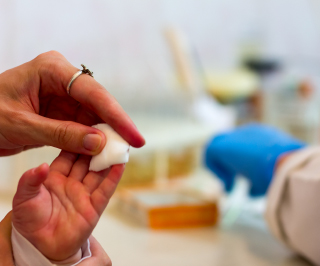
Credit: iStock.com / gutaper
As blood lead levels (BLL) in young children continue to decline, the challenge rises for laboratories to detect BLLs at lower reference values. Researchers at the Centers for Disease Control and Prevention (CDC) have suggested that CDC lower its threshold from 5 μg/dL based on the 97.5th percentile distribution of values for children aged 1-5, to 3.48 μg/dL.
In a study in Pediatrics, they acknowledge that this will be a difficult threshold to reach. Many labs haven’t addressed critical issues with their analytical methods, and as a result aren’t able to quantify low BLLs. Contamination also sometimes affects results.
Lead poisoning in children is a serious issue, resulting in long-term health consequences involving neurological disorders and cognitive
deficits. In 2012, CDC’s Advisory Committee on Childhood Lead Poisoning Prevention (ACCLPP) suggested that the agency adopt the 5 μg/dL population-based reference value to identify at-risk children and high-risk environments.
ACCLPP, which based its recommendation on 2007-2010 National Health and Nutrition Examination Survey (NHANES) blood lead results, suggested that CDC update this value every 4 years to reflect the latest NHANES data. CDC agreed with the recommendations.
The 97.5th percentile at 3.48 µg/dL proposed threshold is based on newer data from NHANES, which reflects declining BLLs in children, and is 30% lower than the current reference value. In the Pediatrics article, the CDC researchers who calculated this lower value describe the potential impact of this change on laboratory operations.
In response to this drop in BLLs, along with stricter proficiency testing criteria, labs have had to adopt newer technologies that yield lower limits of detection (LODs) and more precise results.
CLIA acceptability criteria allow an imprecision of ±4 µg/dL or ±10%, whichever is greater, for blood lead measurements. A 3.48 µg/dL reference value “would require that many clinical laboratories work to improve their analytical accuracy and precision and lower their blood lead reporting limits,” Kathleen L. Caldwell, PhD, the study’s lead author and research chemist in CDC’s Division of Laboratory Sciences, told CLN Stat.
Nearly 180 U.S. labs participate in the voluntary Lead and Multi-Element Proficiency (LAMP) performance and quality assurance program, which seeks to promote high-quality measurements of whole blood lead, mercury, cadmium, selenium, and manganese. A 5-year review of target blood lead values <11 µg/dL determined that participating LAMP labs were more proficient at finding BLLs >5 µg/dL than at lower BLLs.
Just a small percentage of the labs were unable to meet a target BLL of 4.60 µg/dL (less than 6%), compared with 40% who failed to quantify and report a nondetectable result at a target BLL of 1.48 µg/dL. Only a quarter of the LAMP-participating labs reported LODs between 3 and 5 µg/dL, making it unlikely that many would be able to quantify BLLs within the 97.5th percentile value range, according to the study authors.
Unrecognized contamination is another factor that affects results. CDC, in preparing for blood lead measurements for NHANES 2015-2016 data, determined that 35% of the devices used for blood collection had external lead source contamination at unacceptable levels.
“Contamination of the analytical environment, analytical supplies, or the sample collection supplies has an additive effect on the blood lead measurement as that measurement approaches the limit of detection,” according to Caldwell. This can result in false-positive blood lead levels.
Proficiency testing and external quality assurance programs only test the analytical process, not the sample collection process, she continued. “A laboratory can successfully pass required proficiency testing and still provide inaccurate results if efforts are not made to ensure collections supplies are free from external contamination,” added Caldwell.
To successfully lower their LODs, labs need to evaluate their potential sources of external lead contamination, looking at their environment, all collection devices, and analytical testing supplies, Caldwell suggested. “Anything that is exposed to the blood throughout collection and analysis needs to be screened to ensure minimal lead contamination. To measure lead at low levels, methods need to be optimized to give better performance at the low end—giving consideration to the entire analytical process,” she said.
It may be necessary for labs to consider alternate technologies that can reach the lower reporting limits, Caldwell continued. “Users can work to ensure their environment is as free from external contamination as possible and that their collection devices are screened for lead contamination.”
Labs could also tighten blood lead acceptability criteria in proficiency testing to ±2 µg/dL (≤20 µg/dL) or ±10% from ±4 µg/dL (≤40 µg/dL) or ±10% to more effectively deal with contamination and measurement issues associated with very low BLL analysis. Manufacturers of blood collection materials and containers, cryovials, and reagents could also take steps during production to prevent lead contamination of their products, according to Caldwell and her co-authors.